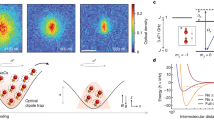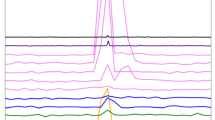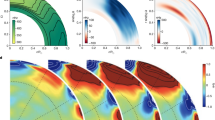Abstract
Most spiral galaxies are believed to be embedded in dark massive haloes1,2. The main observational evidence for their presence is the rotation curves of edge-on disks at large radii measured both by optical3,23 and radio (21cm)4 techniques: rotation velocities remain constant to distances of several tens of kiloparsecs, far beyond the main visible bodies of the galaxies. This suggests the existence of a dark halo whose mass, if spherical, varies linearly with distance R from the galactic centre and hence has a density profile which falls off as R−2. The extended ‘flat’ shape of the haloes poses a problem for most theoretical hypotheses of galaxy formation because simulations of collapse5–8 and of violent mergers9 predict a spherical density profile which is rather Hubble-like (ρ∝R−3) or even steeper. The time scale for two-body relaxation, which can lead to a flatter, isothermal, density profile, is much larger than the Hubble time. If, as Gunn10 and Gott6 have suggested, secondary cosmological infall produces the ρ∝R−2 haloes, special initial conditions are required: (1) the central perturbation, which is the progenitor of the galaxy, needs to be initially embedded in a bound homogeneous background—an assumption which might not be fully justified for relatively isolated galaxies; and, (2) the infall must be such that there is no dissipation so that most of the mass should already be in the form of compact objects before halo formation. We suggest, as an alternative mechanism, tidal interactions between haloes, or possibly between their smaller building blocks, while in the hierarchical gravitational clustering process. In this process typical tidal encounters are slow, such that relative orbital velocities of the interacting systems are comparable to the internal velocities of the stars in each system. The two systems are slightly unbound.
This is a preview of subscription content, access via your institution
Access options
Subscribe to this journal
Receive 51 print issues and online access
$199.00 per year
only $3.90 per issue
Buy this article
- Purchase on Springer Link
- Instant access to full article PDF
Prices may be subject to local taxes which are calculated during checkout
Similar content being viewed by others
References
Ostriker, J. P., Peebles, P. J. E. & Yahil, A. Astrophys. J. Lett. 193, L1 (1974).
Faber, S. M. & Gallagher, J. S. A. Rev. Astr. Astrophys. 17, 135 (1979).
Rubin, V. C. Comments Astrophys. 8, 79 (1978).
Krumm, N. & Salpeter, E. E. Astr. Astrophys. 56, 465 (1977).
Peebles, P. J. E. Astr. J. 75, 13 (1970).
Gott, J. R. Astrophys. J. 186, 481 (1973); 201, 296 (1975); Ann. Rev. Astr. Astrophys. 15, 235 (1977).
Aarseth, S. J. & Lecar, M. A. Rev. Astr. Astrophys. 13, 1 (1975).
Larson, R. B. Mon. Not. R. astr. Soc. 166, 585; 169, 229 (1974); 173, 671 (1975).
White, S. D. M. Mon. Not. R. astr. Soc. 184, 185 (1978).
Gunn, J. E. Astrophys. J. 218, 592 (1977).
Dekel, A., Lecar, M. & Shaham, J. Astrophys. J. (in the press).
Bergeron, J. & Gunn, J. E. Astrophys. J. 217, 892 (1977).
Rees, M. J. in The Evolution of Galaxies and Stellar Populations (eds Tinsley, B. M. & Larson, R. B.) 339 (Yale University Observatory, 1978).
Peebles, P. J. E. in Physical Cosmology (Gordon and Breach, Edinburgh, in the press).
Dekel, A. & Shaham, J. Astr. Astrophys. 74, 186 (1979); Preprint. Hebrew Univ. of Jerusalem (1980).
Aarseth, S. J. Gravitational N-body Problem (ed. Lecar, M.) 373 (Reidel. Dordrecht. Holland, 1972).
Ahmad, A. & Cohen, L. J. comp. Phys. 12, 389 (1973).
Layzer, D. Gen. Rel. Gravit. 8, 3 (1977).
DaCosta, L. N. & Knobloch, E. Astrophys. J. 230, 639 (1979).
Roos, N. & Norman, C. A. Astr. Astrophys. 76, 75 (1979).
Aarseth, S. J. & Fall, S. M. Astrophys. J. 236, 43 (1980).
White, S. D. M. & Rees, M. J. Mon. Not. R. astr. Soc. 183, 341 (1978).
Rubin, V. C., Ford, W. K. Jr & Thonnard, N. Preprint, Carnegie Inst. of Washington (1980).
Author information
Authors and Affiliations
Rights and permissions
About this article
Cite this article
Dekel, A., Lecar, M. & Shaham, J. Tidal effects on the mass profile of galactic haloes. Nature 286, 135–136 (1980). https://doi.org/10.1038/286135a0
Received:
Accepted:
Issue Date:
DOI: https://doi.org/10.1038/286135a0
Comments
By submitting a comment you agree to abide by our Terms and Community Guidelines. If you find something abusive or that does not comply with our terms or guidelines please flag it as inappropriate.



